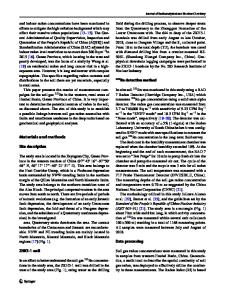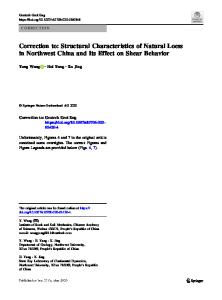Origin of clay minerals on section of Luochuan loesspalaeosol in Shaanxi Province, northwest China
- PDF / 2,138,106 Bytes
- 11 Pages / 595.276 x 785.197 pts Page_size
- 24 Downloads / 386 Views
RESEARCH ARTICLE
Origin of clay minerals on section of Luochuan loesspalaeosol in Shaanxi Province, northwest China Chang Dok WON (✉)1, HanLie HONG2,3, Kum Ryong PAK1 1 Kim Chaek University of Technology, Pyongyang 999093, D.P.R. of Korea 2 School of Earth Sciences, China University of Geosciences (Wuhan), Wuhan 430074, China 3 State Key Laboratory of Biogeology and Environmental Geology, China University of Geosciences (Wuhan), Wuhan 430074, China
© Higher Education Press 2020
Abstract Crystallinity, polytype, and morphology of clay minerals in the Luochuan loess-palaeosols in Shaanxi Province, northwest China were studied in order to have an insight into their origin using X-ray diffraction (XRD) analysis and scanning electron microscopy (SEM) methods. The SEM observations showed that the morphology of some illites seems to be lath-shaped crystals. An analysis of illite crystallinity (IC) on the Luochuan section indicated that the origin of illite was related to the rocks of an anchizone. Most illite in the Luochuan loess-palaeosol section were of 2M1 polytype, but some were of 1M polytype formed by weathering of feldspar in the process of pedogenesis. Illite in the Luochuan section has undergone both physical and chemical weathering. These results revealed that most illite were of detrital origin related to the source area of an anchizone, but parts of the illite were of an authigenic origin formed during pedogenesis after sedimentation. Chlorites in the samples of the Luochuan section were mainly composed of irregular flaky grains and their crystallinity was good. These showed that chlorite had the detrital origin formed by physical weathering. Kaolinite crystallinity was relatively good. The value of CIA on the Luochuan section ranges from 61.9 to 69, and therefore kaolinite could not be formed during weathering and pedogenesis. These results indicated that the kaolinite had a detrital origin. Morphology of smectite seems to be capillaceous. The XRD patterns of all samples contained diffraction peaks at 1.5218 Å (nontronite) and 1.5052 Å (montmorillonite), thus indicating an intermediate composition between trioctahedral and dioctahedral smectite. The smectite crystallinity was very poor. These results revealed that smectite in the study area was authigenic rather than detrital origin. Received February 28, 2020; accepted July 15, 2020 E-mail: [email protected]
Keywords clay minerals, crystallinity, loess-palaeosol, origin, polytype
1
Introduction
The origin of clay minerals is often intricate, but understanding of origin of clay minerals is required for a paleoclimatic reconstruction. The clay minerals in recent sediments usually contain both detrital and authigenic clays, and the detrital minerals account for the majority of clay minerals (Singer, 1984; Eslinger and Pevear, 1985; Trindade et al., 2013). The hypothesis that most of the clay minerals in recent sediments are of detrital origin has been supported by many investigations. The paleoclimatic parameters of detrital clay minerals are thus,
Data Loading...











